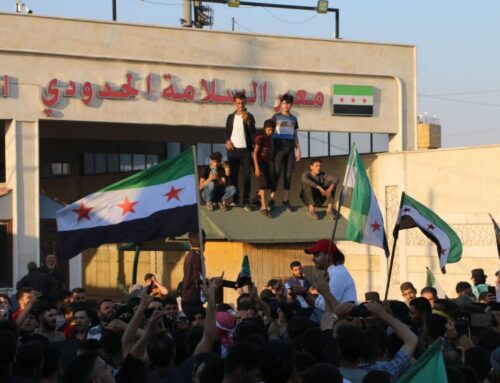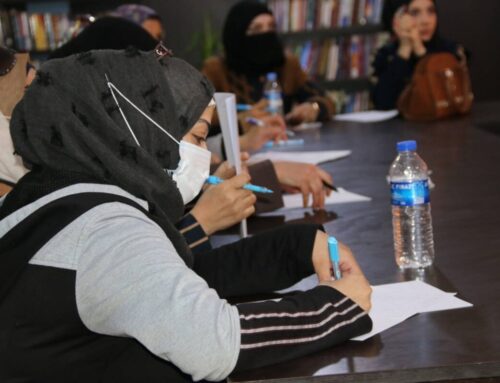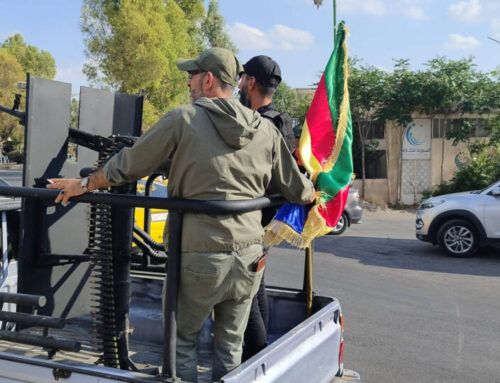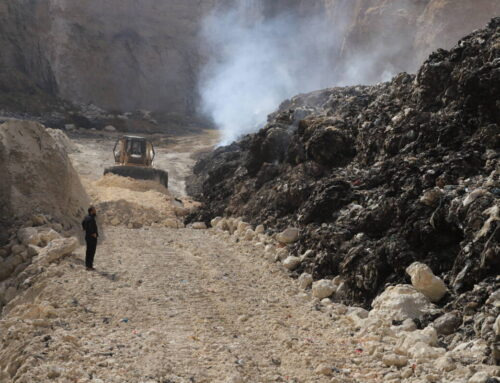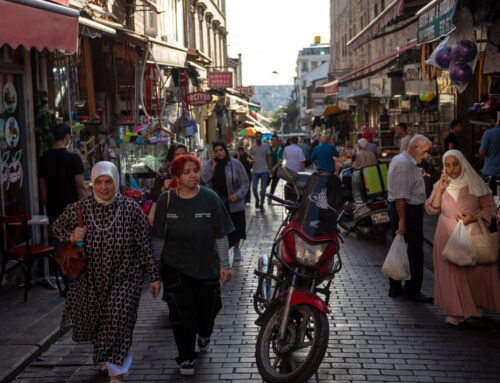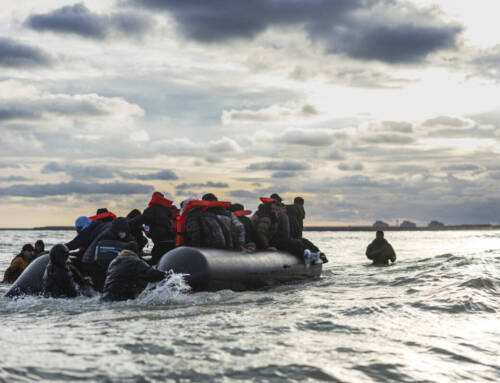Restrictions on local journalists in northeastern Syria multiply
For journalists, northeastern Syria is a minefield of unspoken red lines. While the AANES says it is committed to freedom of the press, restrictions have proliferated in recent years.
4 July 2024
PARIS/BEIRUT — Over his years working as an independent journalist in northeastern Syria, Mazloum Hassan* has grown familiar with navigating a minefield of unspoken red lines. That has become more difficult in recent years, with a “clear decline in the margin of press freedoms,” he told Syria Direct from Qamishli.
Long described as a “kingdom of silence,” Syria currently ranks second to last in press freedoms globally—below Afghanistan and just above Eritrea. While the challenges journalists face differ across the country’s various areas of control, restrictions on press freedom are a common feature. Areas controlled by the Autonomous Administration of North and East Syria (AANES) are no exception.
On the surface, the AANES proclaims a deep commitment to freedom of expression, including for journalists. A new provisional constitution ratified in 2023—the Social Contract—enshrines “freedom of belief, conscience, thought and opinion” for millions of people living in Hasakah and parts of Aleppo, Raqqa and Deir e-Zor.
A 2021 Media Law also declares that “a journalist’s freedom is protected by law” and that any information or opinion “may not be a reason for arrest or infringement on freedom.”
What Hassan has experienced paints a different picture. Like other local journalists Syria Direct contacted, he would only speak with the protection of a pseudonym. He has been arrested by the AANES, beaten and had his equipment destroyed by a group affiliated with the de facto authorities. He has also been prevented from obtaining required press credentials from the AANES’ Free Media Union, he said, restricting his ability to work.
“The AANES seeks to present an experiment with fewer restrictions and violations against journalists than regime and opposition areas, but this comparison may not be very precise,” Hassan said.
Media organizations operating in AANES-run areas have been blacklisted, year after year. In 2021, just a month after the media law was adopted, local authorities forced the Kurdish news website Kurdistan 24 to shut down its local operations, accusing it of “spreading hate speech and fomenting discord.” The following year, another Kurdish news platform, Rudaw, was shut down under the pretext of “inciting strife and distorting the image of institutions working in northeast Syria.”
Both outlets were viewed as mouthpieces of the Kurdish National Coalition (KNC), a political rival of the Democratic Union Party (PYD), the leading party within the AANES. More recently, journalists renewing their press cards have reportedly been told not to work with Syria TV, a Qatari-owned news outlet based in Turkey. News organizations that remain are either aligned with the AANES or operate independently with the support of United States (US) or European funding.
In February 2024, the AANES also began requiring media organizations operating in northeastern Syria to provide it with details about their staff and reveal individual employees’ background information upon request, raising safety concerns for local journalists.
A high-ranking source in one European development organization that funds media in northeastern Syria confirmed that challenges have notably increased this year. Speaking on condition of anonymity due to the organization’s zero-visibility policy in Syria, the source cited requirements that journalists join the AANES’ press union and difficulties holding events related to press freedom.
Jiwan Mulla Ibrahim, the co-chair of the AANES Media Department, told Syria Direct his government’s 2021 media law, which requires journalists to join the government-affiliated union to receive press credentials, aimed not to restrict press freedom but “help journalists perform their duties and restrict the media chaos that northeastern Syria faced.”
Intimidation
In May, farmer protests broke out across northeastern Syria in response to a low wheat price set by the AANES. As journalists covered one protest in Raqqa, three were assaulted by the Syrian Democratic Forces (SDF), the armed component of the AANES. One, Abdullah al-Khalaf, was arrested. After facing physical and verbal assault in detention, he was forced to delete all photos, videos and interviews with farmers as a condition of his release.
Two months earlier, the AANES’ Internal Security Forces (Asayish) attacked a protest organized by local activists in Raqqa city to mark the anniversary of the 2011 Syrian revolution. Marwa Nassif, a local journalist covering the event, was assaulted and her equipment was confiscated.
Nassif filed a formal complaint, but “was forced to drop it, and the SDF did not hold the officer who assaulted her accountable,” Samer al-Rashid*, a freelance journalist in Raqqa who witnessed the assault, said. Syria Direct reached out to Nassif, who declined to comment on the incident.
“After the attack, we were interrogated by the SDF and they asked us not to provide any information about the incident to any media or human rights organization,” al-Rashid said, calling the incident a sign of “declining freedoms in the northeast.”
Sometimes, intimidation comes from unidentified groups thought to be acting at the behest of local authorities. Jakerkhoun Ali*, the former head of a local Kurdish media outlet, said he and his organization have faced systematic intimidation.
Ali recalled one incident that took place after he published a report on battles between the SDF and Islamic State (IS) forces in 2022. Rather than being summoned by a formal body, such as the Free Media Union or the courts, he was sitting in a cafeteria one day when a group of men approached and stood over him.
“They told me to come with them. I told them to show me their identification, but they said to shut up and come,” Ali said. “I went with them, and they interrogated me for over five hours.” His outlet took down the report.
Fear tactics like this, alongside online smear campaigns and threatening calls from unknown numbers, force journalists to weigh the risks of covering certain topics, creating a form of self-censorship. “It puts you under the constant pressure of fear, so you’re always thinking about the consequences, which impacts your thinking and profession,” Ali added.
“You’re working in a minefield, you have to be careful not to make a mistake,” Siruan Hajj Hossein, the director of independent radio station ARTA FM, echoed. “This takes a lot of energy, thinking all the time not to make a mistake.”
In April 2016, ARTA’s headquarters in Hasakah province’s Amouda city was attacked and burned, knocking the station off the air for a month. “The Self Administration admitted that the Revolutionary Youth [Ciwanên Şoreşger],” a group tied to the ruling PYD, “were behind it,” Hossein said. “They apologized and told us they would punish them.”
The Revolutionary Youth has been accused of involvement in similar violations, including burning offices belonging to the rival KNC on multiple occasions, most recently in Qamishli in May. The KNC accuses the AANES of responsibility, which it denies.
In response, Ibrahim of the AANES’ Media Department stressed “we are against any violation or infringement on the media of any member of the press, or any individual working in the scope of freedom of expression.” He noted that “previously in Syria, there were no press freedoms, so our experiment after 2011 is new, and we are still trying to develop ourselves and our journalists.”
Red lines
All the journalists Syria Direct spoke to said there are red lines they cannot cross in their coverage without risking detention and arrest.
“The [only] freedom is in covering services. If you want to talk about a political topic, you can’t talk about it at all,” al-Rashid, the journalist from Raqqa, said. But even covering basic services in an Arab-majority area such as Raqqa, where the AANES’ legitimacy is fraught, can be considered political. “When we spoke about worsening services in Raqqa city, we faced issues and were stopped” by the security forces, he said.
Other red lines include government corruption, the recruitment of minors, the drug trade, sex trafficking, oil revenues and security issues.
Ali said his organization has been forced to remove a substantial amount of content deemed “incitement” by local authorities. On one occasion, a report on corruption in the service sector led to his organization being taken to court. While they were later found innocent, it sent “a clear message,” he said.
While clamping down on the media is “definitely unacceptable,” multiple factors contribute to it in the northeast, Simaf Hassan, head of advocacy and communications at the rights organization Syrians for Truth and Justice, said.
Some restrictions relate to security concerns and the persistent threat of Turkish attacks. Meanwhile, international organizations such as Amnesty International report on “violations committed by the AANES, so it is possible the AANES believes local [media] bodies are the ones providing information…and restrict their work and access as a result,” she added.
“Turkish threats, and other threats facing northeastern Syria, could place barriers and limits to the freedom of journalists,” Ibrahim of the AANES Media Department said. “There are security or military matters that are outside the scope of freedoms,” he added. “For this reason, we are obliged to protect our institutions and protect our colleagues who work there.”
Facing restrictions in the northeast, media organizations have little option but to censor their work and avoid crossing red lines. “We don’t see ourselves as the BBC of northeast Syria,” Hossein of ARTA FM said. “It could not exist if not for the law that safeguards it in Britain. They can criticize anybody and the law protects them.” In Syria, “there is only the law of weapons, so you have to be careful about what you report on.”
Rules and regulations
Bureaucratic regulations and restrictions have proliferated in recent years, especially for independent organizations and journalists. “If you are independent, you face a lot of challenges because you don’t belong to any party in power,” Hossein said.
Requirements include obtaining a security approval and press cards, as well as joining the AANES’ Free Media Union. In addition, journalists are required to pay annual fees that add a financial barrier to an already precarious industry.
Aram Salem*, an independent journalist in Hasakah, has had to stop working because local authorities have delayed renewing his press permit due to work he did for a media organization that is not licensed by the AANES, he said. “The AANES only grants permits to Arab and international media outlets that support their political orientations,” he contended.
“Non-registered entities are not allowed to work in the field of journalism,” Ibrahim of the AANES said. “However, they can obtain authorization or permission by sending an official email or delegating a journalist in northeastern Syria.”
A legal requirement that journalists work exclusively with a single media organization is only applied to independent journalists, Salem said. As many independent journalists are freelancers, this limits their ability to make a living. He alleged journalists working with media affiliated with the PYD are, in practice, exempt from the requirement.
Hassan, in Qamishli, also noted discrimination between media institutions and journalists, stressing this is not related to ethnicity or religion, but rather a “purely political issue” related to those who are aligned with the de facto government and those who are “independent or opposed” to it.
Rashid, the journalist from Raqqa, who is Arab, agreed that “violations are against all journalists,” while adding that “Arabs generally are the most oppressed.” Fewer Arab journalists are likely to have relatives working within the largely Kurdish AANES who could afford them a degree of protection, he said.
Restrictions also prevent journalists who are not aligned with the PYD from covering certain events, Salem said. For example, only media organizations close to the AANES are allowed to cover al-Hol camp, where thousands of family members of IS fighters are held, or clashes in Deir e-Zor between the SDF and local clans.
The overall picture, Hassan said, is that local authorities to exert control over local and international media operating in the northeast “by appointing loyal correspondents in Arab, Kurdish and international channels and agencies while not providing a safe space for others to work, and pressuring them to adopt a media discourse that aligns with it.”
‘Least authoritarian’
By most metrics, the situation for journalists in northeastern Syria remains better than in regime- and opposition-controlled parts of Syria. Since 2011, the Syrian regime has killed 554 journalists and opposition factions and Hayat Tahrir al-Sham (HTS) have killed 34, while the SDF has killed eight, according to the Syrian Network for Human Rights.
Out of the eight violations against journalists documented by the Syrian Journalist Association’s Turkey-based Center for Journalistic Freedoms in the first quarter of 2024, two were committed in northeastern Syria, the organization told Syria Direct.
Across Syria, the level of “the most severe violations such as killing and injury has decreased with the decline in the intensity of military operations,” Ibrahim al-Hussein, the head of the Center for Journalistic Freedoms, said. However, this does not mean “the level of journalistic freedoms has improved,” he added. “Clamping down on journalism continues in all areas, including AANES regions.”
While Mazloum Hassan has been arrested and beaten in the northeast, he noted that the AANES has not assassinated journalists as in other parts of the country, describing the “margin of freedoms” as “incomparable.” Still, he held that the margin must be “wider” and “protected by local authorities.” In a region under threat from Turkey, which views the AANES as an extension of the Kurdistan Workers’ Party (PKK), instability breeds censorship, he explained.
Salem also conceded that conditions for journalists are better in northeastern Syria than elsewhere, calling the local authorities the “least authoritarian.”
As for prior to 2011, the conditions are beyond comparison, particularly for Kurdish media. “I established the first Syrian Kurdish news website in 2000,” an illegal act at the time, Hossein of ARTA FM said. “The conditions now are much better. I cannot compare—I was not allowed to enter Syria before 2013, before the AANES took power.”
“ARTA was the first independent radio station. This would not be possible if the Syrian regime was still in power [in the northeast]. Of course, we are not happy with everything, we have a lot of problems on the ground with the Autonomous Administration, but still it’s better than having the Syrian regime, Daesh [IS], Jabhat al-Nusra, or Turkish occupation,” he added.
But as Ali sees it, the AANES uses the “same methods” of fear and intimidation seen in other parts of Syria. While local authorities often compare themselves to others within the country, the comparison should be against “the democratic standards it has set for itself, not external standards,” he said.
Advocacy is needed from all stakeholders to pressure the local authorities, Simaf Hassan of STJ said. “Western governments present in the region can play a larger role, such as the US-led international coalition,” she added.
“The United States consistently raises issues of press freedom with local authorities in northeast Syria and advocates for the essential role journalists and media workers play, as they do in all parts of Syria” one US State Department official told Syria Direct. The official acknowledged reports of the arrest and suspension of local journalists.
But ultimately, it is “local civil society organizations that must press for the expansion and protection of freedoms,” Hassan of STJ said. “Pressure doesn’t have to come from outside.”
“We can remind them of their international obligations to protect civil space and not commit violations, and we can also pressure them to implement their commitments outlined in the Social Contract,” she concluded.
*All journalists Syria Direct spoke to inside Syria requested anonymity due to fears of negative repercussions from local authorities.


